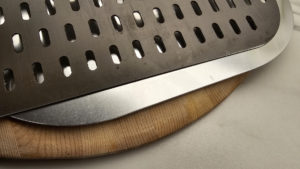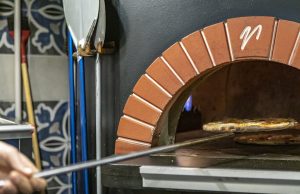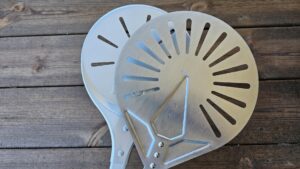A
What Is a Pizza Peel ?
A
Pizza peels consist of two main elements: a flat carrying surface and a handle.
The carrying surface, also called the blade, of the pizza paddle, is where you place the pizza. This area, therefore, has to be large enough to hold the pizza you’re baking. The carrying surface is usually made either from wood or metal. When we refer to a wooden or metal peel, it’s the material the carrying surface is made from we’re talking about.
The handle has two main functions: provide a stable grip and extend the reach of the paddle. Since a
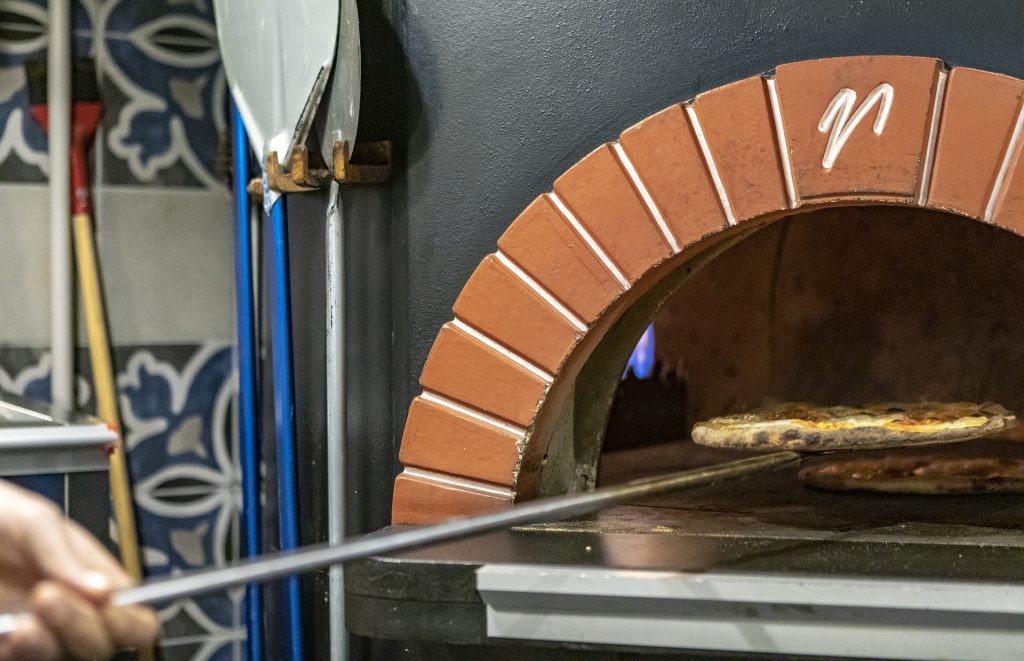
Do I Need a Pizza Peel ?
I often get this question, and yes, you need a
If you bake pizza on a baking tray you don’t need a
When I first started my pizza journey and just got my first pizza stone, I didn’t own a
I was in Italy the following summer and came across a cute, little metal
Types of Pizza Peels – Find the Best Peel for Your Needs
Pizza peels come in a variety of shapes, sizes, and materials. They can be round, squared, have long handles, short handles, and be thin or thick. What kind of peel you need depends on what you’re going to use it for, and what kind of oven you have. Different peels work better for transferring the pizza into the oven, some are better for moving and turning the pizza in the oven, and others for removing the pizza from the oven. Here are some of the things to consider to find the right peel.
Pizza Peel Carrying Surface
There are two main types of carry surfaces for pizza peels: solid and perforated.
A solid carrying surface is what you find in most pizza peels, a flat, whole surface without any holes, dents, or groves.
A perforated carrying surface, on the other hand, is a surface filled with lots of small holes. The benefit of a perforated peel is that the holes will help you get rid of excess flour from the dough. You want to get rid of this flour, because the flour will burn in a hot oven, creating smoke and giving the pizza crust unpleasant flavors. Perforated peels are most commonly made from metal. But the added holes make pizza dough stick less to the peel than a metal peel with a solid carrying surface.
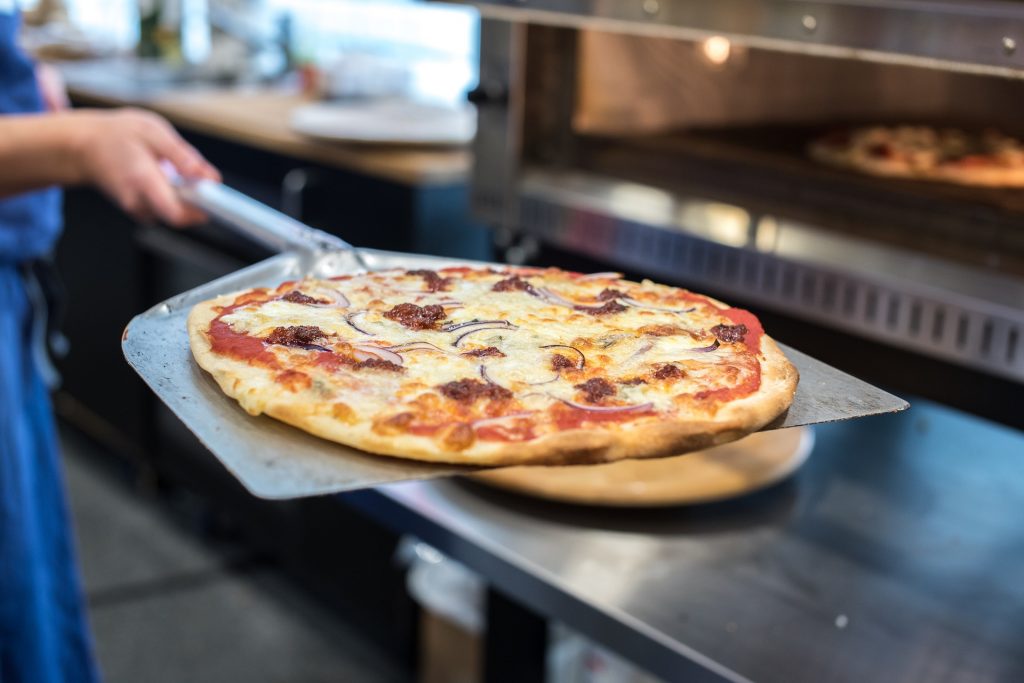
Pizza Peel Thickness
How thick should your
Most metal peels (with a carrying surface made from metal) are thin because the material allows them to be made thinner. However, you don’t want the peel to be too thin, because then the carrying surface can get flimsy. Ideally, you’re looking for something in the 1-3 mm (3/64-1/8 inch) range.
Wooden peels, tend to be thicker since you can’t make the wood as thin as metal. A wooden peel works great for transferring the pizza into the oven, but it’s less ideal to get it out. Wooden peels typically are too thick to easily slide under the pizza (without using any tools to lift the pizza). A thin, beveled edge can help, but in general, I recommend metal peels to get the pizza out of the oven.
Handle
You can find handles in all kinds of lengths and materials. Whether you need a long or a short handle depends on what kind of oven you bake your pizza in. For big, commercial ovens, the long handle will come in handy. The same goes for traditional wood-fired ovens, because of the size and heat. If you’re baking pizza at home, a
Besides the length of the handle, the most important feature is comfort. Handles are usually made out of either metal or wood, but can also come in plastic, rubber, or other materials for better grip.
When you’re looking for a peel, I recommend going for a long handle peel if you’re baking pizza in a
Pizza Peel Material
Wooden Pizza Peels
A wooden
Another benefit of wooden peels is the price. They are fairly cheap to acquire. The downside of wooden peels is that they are not that easy to clean and require more maintenance. You also need to be careful with heat and water to avoid cracks and warping of the wood. Wooden peels also tend to be thick, which makes it harder to get under the pizza for turning or getting it out of the oven.
Metal Pizza Peels
Most metal pizza peels come in either stainless steel or aluminum. They’re more durable and easier to clean than wooden peels and generally need less care. Metal peels are also thinner than wooden peels, making them the perfect tool to get under the dough. Metal peels, therefore, work well to turn the pizza in the oven and to pull the pizza out when it’s done. The main drawback of metal peels is that raw dough sticks more easily to the peel.
To overcome this drawback, you can get a perforated metal peel. Dough sticks much less to these peels, due to all the tiny holes in the carrying surface. These holes allow airflow under the dough. This prevents a vacuum from being created between the dough and the peel, which is the main reason dough sticks to a metal surface. If you want to know more about perforated pizza peels and their benefits, check out this article.
Should You Choose a Wood or Metal Pizza Peel ?
Wood and metal peels both have their strengths and weaknesses. And to get the best from both worlds, I recommend having both. If you, however, just want one peel, your best bet is a perforated metal peel because it’s the most versatile option.
A wooden peel is the best choice when it comes to transferring the pizza into the oven. The reason is that pizza sticks less to a dusted wooden surface than a metal surface. The thickness of the paddle is however not ideal when you want to slide it under the pizza to either turn it or take it out of the oven.
A metal peel is thinner, making it easier to slide under the pizza. It also works for transferring the pizza from the working surface into the oven, but you have to be more careful. Pizza sticks more to metal, you can however solve this by drizzling semolina on the paddle, in addition to minimizing the time for your pizza on the carrying surface.
The last option is to get a perforated metal peel, that will give you the best of both worlds. It both has a thin carrying surface, and pizza dough sticks less. A perforated
How to Use a Pizza Peel
The main purpose of a
Transfer the Pizza into the Oven
I love to use a wooden peel for this. As mentioned above, the pizza doesn’t stick as easily to wooden peels, therefore the wooden peel is the perfect peel for this. When you assemble the pizza you can either do it on the countertop or on the peel.
I like to both shape the pizza and top it on the countertop, to minimize the time on the paddle. The reason is that it will make it less likely to get stuck. If you’re worried about the shape of the pizza when you drag it over to the peel, you can always readjust it before it goes into the oven.
Before moving the pizza to the peel, dust the peel lightly with semolina. The Semolina flour really helps the dough slide off easier, as well as adding a little bit of texture. I recommend shaking the pizza on the paddle right before it goes in the oven, just to make sure it’s not stuck.
If the dough is stuck to the working surface, simply use a dough scraper or a spatula to loosen it before it goes onto the peel.
If you choose to use a metal
Turning the Pizza in The Oven
Whether you’re using a wood-fired oven or your kitchen oven, ovens usually don’t distribute heat evenly. If you need to move the pizza around in the oven to ensure even baking, a thin metal peel is the best option. There are special peels made for this purpose, but a regular metal peel should work fine for the home chef.
If you bake pizza in a wood-fired oven, you should place the pizza back in the same spot if you turn it, or else the hot deck of the oven may burn the pizza. But the hot surface may bake the bottom of the pizza faster than the top. If the crust is done but the cheese is not melted yet, you can use the peel to lift the pizza closer to the dome of the oven, where the air is hotter, for a few seconds to finish it off.
Remove the Pizza From the Oven
As for turning pizza in the oven, removing the pizza is easy with a thin, metal peel. You can use a wooden peel for this as well, but a metal
The Best Pizza Peel : How to Choose the Right Type
In general, I recommend having two types of pizza peels: one made out of wood and one made out of metal. The reason is that they both have their strengths and weaknesses and having both gives you the best of both worlds.
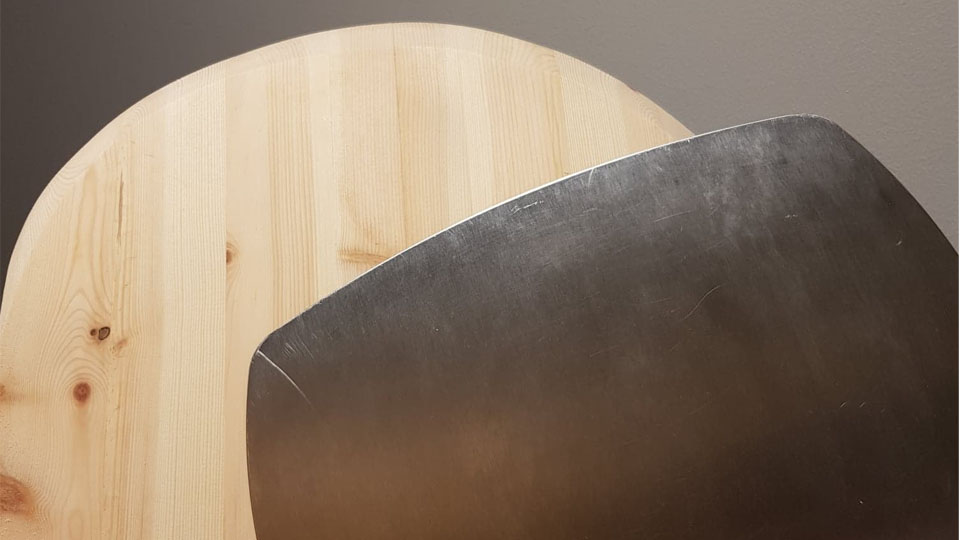
The Best Pizza Peel For Commercial Pizza Ovens
The most important factor for peels for wood-fired pizza ovens is the long handle. The reason is that these ovens are very hot and usually pretty big. Therefore, you need a long handle to reach the back of the oven, and to be able to move the pizza in the heat. Weight is another important thing to consider if you’re using the peel all day in a pizzeria. The peel must also thing be able to handle the heat from the blazing hot oven.
The Italian company Gi. Metal makes some of the best professional
Elevate your pizza game with the professional-grade Gi.Metal Pizza Peel. Its lightweight yet durable design ensures seamless use, making it the ideal tool for pizza makers at any level.
The Best Pizza Peel for the Home Cook
There is no ‘the best
The Best Wooden Pizza Peel
First off, the wooden peel. The best wooden
The peel comes in two sizes: large and extra-large. The large version is 12 inches (31 cm) wide, and the extra-large version is 15 inches (38 cm). The size of the peel determines how large a pizza you can bake on it. A larger peel allows for baking bigger pizzas. In my opinion, the large-size version is a bit small, so I recommend the extra-large version. since that allows for making larger pizzas.
Pizza Royale’s Bamboo
A high-quality wooden pizza peel, made from bamboo and capable of fitting a 12-inch pizza, comes with a 180-day guarantee.
The Best Metal Pizza Peel
My choice for the best metal
Another benefit of this peel is that it’s easy to take care of. You can clean it with soap and hot water, and don’t need to worry about rust, since it’s made out of aluminum.
Because it’s comfortable to use, is of high quality, and comes with a nice, aluminum finish, this US-made
Featuring an anodized aluminum blade and a solid basswood handle, the New Star Foodservice Aluminum Pizza Peel is ideal for daily use. The thin aluminum blade makes it easy to slide the peel under any pizza, ensuring easy launching and retrieval!
The Best Perforated Pizza Peel
My top pick for perforated
This is a sturdy, well-made peel, with a nice smooth finish on the carrying surface. This combined with the holes makes it super easy to slide off pizza, and you don’t need to worry about sticking. And at only 1.7 lbs (770), it’s lightweight and easy to maneuver.
Homevibes 12″ Perforated
This lightweight premium, anodized aluminum peel features a balanced 12x14-inch blade for effortless handling and a perforated surface to reduce sticking.
Pizza Peel Maintenance
Wooden Pizza Peel Maintenance
I would avoid cutting pizza on the wooden peel, as this will make scratches. When you’re cleaning you should avoid using too much water, especially hot water, because this can make the wood warp or crack. You should therefore never put it in the dishwasher! Before washing, I recommend using a plastic dough scraper to get rid of anything that is stuck to the peel. You can use a metal scraper as well, but it’s easier to scratch the wood if you’re not careful. You can then use a nylon brush or wet cloth to clean it. Make sure to wipe off any excess water before storing it in a dry place.
Mineral Oil for Wooden Pizza Peels
To make a wooden
The benefit of applying mineral oil is that the wood stays hydrated, which prevents warping and cracking. To apply mineral oil, pour 1-2 tablespoons into the peel, and spread using a piece of cloth. It’s a good idea to re-apply oil every 3 months or so.
When picking a mineral oil, make sure it’s food-safe. My recommendation is Thirteen Chefs Food Grade Mineral Oil, which is a US-made mineral oil. This oil is also great for pizza cutting boards and other wooden kitchen tools.
Metal Pizza Peel Maintenance
For metal pizza peels, there is not that much to worry about. Since most metal peels are made from stainless steel or aluminum, you can use soap and hot water to clean them. Because of the smooth surface, it’s also often easier to wipe off anything that is stuck to metal peels.
Related
- Is Your Pizza Dough Too Dry? Here is How to fix it! - June 10, 2024
- The Ultimate Guide to the Pizza Dough Windowpane Test - June 8, 2024
- The Ultimate Guide to Autolyse Pizza Dough - June 7, 2024





